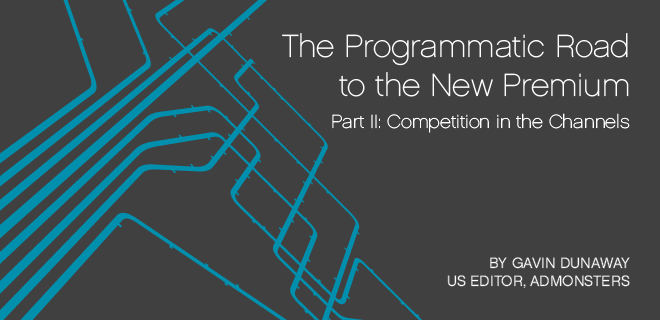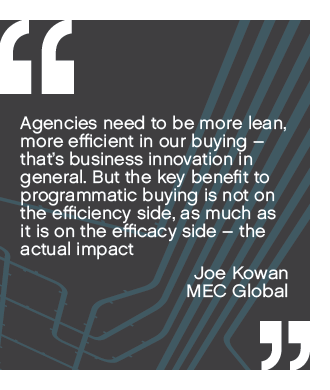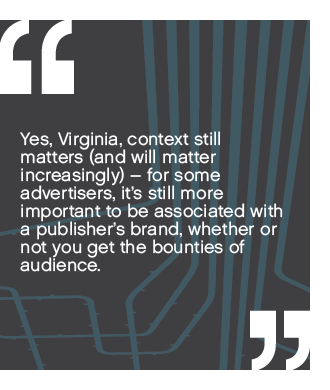
Pop quiz, publisher: Let’s say Brand X purchases $10 guaranteed CPMs from your direct sales team. However, Brand X’s steely programmatic buying team notices a high-prospect user has just jumped on one of your URLs. They’re dying to retarget them, and perhaps at a rate above the $10 CPM.
In the past, you might have blacklisted this advertiser from buying off the spot market, but controls within your supply-side platform now enable you to set up a barrier to entry – your floor just has to be higher than the direct sales CPM.
Logically, you would think the higher CPM should win out – but there are mitigating factors. Under-delivery on guaranteed sales is still a fearsome prospect, and our old foe inventory commoditization may rear its ugly head. What do you do? Oh yeah, there are only microseconds to decide…
The term “Premium is in the eye of the beholder” is becoming a bit tiresome, but the above is a perfect example. Brand X is willing to put down a pretty penny on direct sold inventory – let’s say custom, integrated units – but reaching that one user on the verge of conversion (the ol’ low-hanging fruit) was something they were willing to pay for at a higher rate. Which one is premium? Is one more premium than the other?
In the good old days (i.e., like five years ago), premium was simply direct-sold inventory, while non-premium was anything that went through indirect channels – ad networks, exchanges, etc. Then audience targeting, demand-side platforms and trading desks came along to bolster the buy side and make everything more complicated. Now technology has also empowered publishers to levy additional inventory channels such as programmatic guaranteed and private exchanges, thus further blurring the idea of premium.
In Part I, I noted the irony that widespread adoption of these “programmatic premium” tools will actually destroy the out–dated definition of premium – as many readers will agree, this notion is already on its deathbed. Taking its place is likely the equally amorphous term “native,” which basically is code for customized, integrated campaigns, but debate will rage on that for the foreseeable future.
The first milemarker on the road to the new premium is bringing programmatic efficiencies into guaranteed sales, whether that’s through direct sales teams, third-party programmatic guaranteed providers, or in-house solutions bolstered by technology. The buy side is also increasing transactional efficiencies through streamlined media planning software. But Joe Kowan, Managing Partner, Practice Lead, Digital Investment & Activation at MEC Global, argues that saving media planners time is not the real play.
“Agencies need to be more lean, more efficient in our buying – that’s business innovation in general,” explains Joe Kowan. “But the key benefit to programmatic buying is not on the efficiency side, as much as it is on the efficacy side – the actual impact. Streamlined media planning software will result in time savings from rote work and instead allow more focus on strategic client business issues, which will in turn make their jobs more fulfilling, thus leading to higher productivity, lower churn, increased morale.“
Forward-thinking digital advertising strategists are exploring the myriad possibilities in the expanding publisher tech stack: direct sold (guaranteed), programmatic guaranteed (sold through a third-party platform), private exchange or open marketplace (i.e., exchange).
As Ben Reid, CEO of elasticiti, laid out in a recent piece on AdMonsters, the introductory example is something many publishers can experiment with in their ad server now, without actually letting the transaction take place. Seeing how RTB calls stack up against directly sold guaranteed inventory is a smart way to inform rate-card adjustments.
It’s also good preparation for a future in which inventory channels are increasingly competing against each other.
 Lining Up the Tools
Lining Up the Tools
An advantage of managing the monetization efforts of so many sites big and small is that some can be used as laboratories for nascent ad tech. For example, one publisher we talked to offers the ability to buy guaranteed inventory on a programmatic basis on some of its less trafficked properties. The channel is mainly used by smaller and midsize advertisers that don’t have big enough budgets to attract direct sales, but still want to buy on a guaranteed basis.
Sales channel conflict is always a concern and requires constant reviewing of who is buying and booking. Interestingly, the third-party provider is aware of these worries and alerts the publisher to opportunities for upselling to direct sales.
When it comes to programmatic sales, this publisher boasts the full trifecta: private marketplaces, programmatic guaranteed and public RTB. How much inventory is going through each ebbs and flows based on timing and major events – for example, advertising around a major event (holiday, sports, etc.) is much more likely to be guaranteed native units than anything else.
With its current rate card, there are four levers that go into deciding which channel will deliver an impression across its expansive network of sites:
- Guaranteed vs. non-guaranteed
- Native (custom) unit vs. IAB standard
- Placement
- Site
“They all play into premium, whether we can make it programmatic or not,” a revenue strategist comments. However, directly sold, guaranteed inventory is currently king. “We have to make sure direct sales always ensures delivery and performs to its highest capability.”
Although our model publisher has a full monetization toolkit at its disposal, direct sales account for two and half times the amount of inventory of the other channels, and therefore is treated like royalty. Still, audience-based efforts through private marketplaces have grabbed their own seat as queen.
“Private marketplaces and preferred details are being employed on an increasingly strategic level by advertisers,” the revenue strategist comments. “They help advertisers on performance while addressing brand needs. They’re always aligned with direct sales.” Offering private marketplaces outside of direct deals could lead to difficulties such as competition instead of conjoined efforts, he adds.
Programmatic guaranteed is not a firehose of ad revenue, but it is a newer and smaller channel, one still in the laboratory phase. The publisher has been surprised at the lack of interest from agencies and trading desks, but it’s most important to be prepared to meet buyers at whichever channel they choose.
“We’re hoping to get a better picture of direct sales vs. non-guaranteed,” comments the revenue strategist, “ensuring holistically from an advertiser perspective that people willing to pay more will get the focus they deserve and delivery they expect.”

Programmatic Reserved vs. Private Marketplaces
“Why would an advertiser want programmatic guaranteed inventory?” an attendee asked during a recent publisher forum. I was sitting in on a breakout discussion revolving around programmatic guaranteed, and while none of the publishers in the room were currently offering these kind of sales, their curiosity had been piqued by the media clamor.
The answer is deceptively simple – because it’s reserved.
Let’s think about it this way: Tier 1 inventory is custom, complex guaranteed stuff that’s always top of server – call it native, call it non-standard IAB. Tier 2 is the unsellable that gets kicked out to open exchanges and ad networks. As publishers have better churned their data and bolstered their technology infrastructure, there’s now a lot more in between – what John Ramey of isocket likes to call the “Fat Middle.” This is the mainstay of private marketplaces/preferred deals and programmatic guaranteed.
As you see with the model pub in the last section, the vast majority of private marketplace deals are sold complementary to direct efforts. So if an advertiser wants on a certain publisher but can’t put up the big bucks to warrant direct sales assistance, it has two choices: programmatic guaranteed or bidding it out in the public marketplaces.
The latter has its ups and down – while the advertiser could employ first- and third-party data for targeting purposes (most publishers I talked to did not offer targeting frills with programmatic guaranteed)… It’s not reserved – it’s spot buying.
Yes, Virginia, context still matters (and will matter increasingly) – for some advertisers, it’s still more important to be associated with a publisher’s brand, whether or not you get the bounties of audience. Programmatic guaranteed is reserved, but not prioritized over Tier 1. As Foundry Group’s Seth Levine suggested in an earlier piece, this could be the next big differentiator when it comes to indirect sold inventory.
One of your regular advertisers may have some extra spend and want to push it out in a timely manner – a small guaranteed buy could be the most efficient and effective path. Now whether that’s done through a third-party provider (which offers the bonus of handling the financial aspect of the transaction) or through the ad server or SSP itself will be a matter of preference – we’re likely to see a lot of experimentation with this channel in the near future.
For certain publications, it may make sense to outsource the sale of all guaranteed spots for IAB standard units because of the transactional efficiencies. A wealth of inventory may flow through these channels simply because the CPMs are better than the open marketplaces. For others, there may be no demand for programmatic reserved – think about intender-heavy sites like automobile information providers that will always have audiences in high demand. We could also see hybrid models, such as preferred deals with inventory set at a fixed price.
Of course, what will really turn this landscape on its head is the widespread use of reserved audiences in programmatic sales – also known as audience futures.
Reserve Your Audience Today
The reality is that advertisers want to target audiences, optimize for performance, ensure viewability rates, pause campaigns and shift budgets to different channels for many reasons that don’t reveal themselves until a campaign goes live. To date, the champions of programmatic guaranteed have failed to address this fundamental issue, which, at the end of the day, leaves publishers with little progress toward their end goals of higher revenue and CPMs. Eric Franchi, Undertone
As Legolas Media cofounder and CEO Yoav Arnstein explained in an interview with AdMonsters in 2012, “‘Audience Futures’ refers to the ability of a marketer to purchase advertising rights to specific consumer audience profile targets, in an upfront manner.” Basically, inventory guaranteed against audience. While audience futures could be a direct sales feature, already publishers and third-party companies are experimenting with selling them programmatically.
“Programmatic is great, but it doesn’t give advertisers the leverage they’re accustomed to based on their buying power,” comments Jeremy Steinberg, SVP of Digital Ad Sales at The Weather Company. “I see a futures market developing – activated programmatically but actually more like a direct partnership. This is what we’re most interested in – with so much global demand, we have to segment audiences and sell them upfront.”
Kowan, formerly VP of Business Development at Legolas, agrees guaranteed audience upfronts align with agency agendas.
“We should be able to get volume discounts, locked-in rates that are not subject to volatility and certain high sell-through times,” says Kowan. “We’re big enough, have enough scale and clout, our advertisers are Blue Chip, Fortune 500 – we leverage that in everything we do.”
And advantage goes to the programmatic/automated side, as data can easily seen as one variable too many when it comes to custom direct-sold campaigns.
“Layering on data into premium direct sold is challenging because the CPMs are already considerably higher,” Kowan says. “And you’re typically buying context already, so is adding data going to get you the biggest bang for the buck? Not necessarily.”
Here’s where competition within the channels gets really interesting – an attractive user shows up, and while the guaranteed audience campaign is set at a certain CPM, an advertiser within your private exchange is willing to pay a higher rate to retarget. Who gets that impression?
But this example also brings to the forefront the biggest obstacle for programmatic guaranteed, audience futures and general competition among the channels: forecasting. Already a tough job for the weary ad ops pro, predicting and delivering audience with so many guaranteed variables is a daunting prospect. Under-delivery may still be ad ops’ greatest fear.
As demand for upfront guaranteed audience sales become more common, yield management will only grow in importance. Already many publishers are turning to third parties for assistance in developing strategies and applying predictive audience algorithms.
“If you don’t understand inventory, you’re screwed,” Steinberg says. “How do you start dynamically allocating inventory so you get maximum value for a each page view? Say XYZ advertiser is looking for XYZ audience – we’ve done a match and are pushing impressions directly to advertiser with the highest priority while making sure we deliver on guaranteed commitments.”
Publishers must also understand that like direct sales, these are upfront buys. Advertisers will still heavily leverage private and public spot marketplaces for their specific advantages beyond audience. As Kowan explains, buyers need to also take an agile approach to booking, exploiting unique situations in a timely manner.
“Across any category, any vertical of advertiser, there’s a combination they need to find in their media mix leveraging upfront deals in combination with the spot marketplace,” Kowan argues. “It’s very similar to the broadcast world.”
Beholder’s Prerogative
“What is it with this word premium?” a traveled ad tech executive asked me earlier this year at a conference where I was moderating a panel on programmatic premium. Why does this concept stick around even though the word has been mangled to the point it has little meaning?
“Premium is absolutely still relevant,” Kowan argues. “When you start to start to talk about premium vs. non-premium, attribution is going to be a very important topic.”
Steinberg agrees, saying publishers can help trading desks bridge the gap with various agency media buying teams.
“Publishers must know the branding goals,” he says. “That helps us better operate and track attribution.”
On a higher level, what’s the utopian situation in terms of premium? The advertiser gets what it wants, whether that’s hitting a certain audience, premier placement, contextual relevancy or some combination of these variables. The publisher is appropriately compensated. The intermediary service providers get a slice for facilitating the transaction. So everyone goes home happy – we’ll even suggest consumers find the advertising relevant, informative and unobtrusive.
Thanks to the ad tech revolution, there are multiple routes to make this happen, but they all depend on the objective of the buyer. In writing these articles, I initially postulated that native is the new premium, but that’s a bit inaccurate. To some extent native is just replacing the outdated notion of premium – direct-sold, guaranteed inventory.
In the near future, publisher direct sales will almost exclusively focus on custom, integrated units – the stuff that requires a lot of hand-holding and creative collaboration. Native is the current buzzword for this costlier inventory, its price justified by the amount of time the publisher devotes to assembling and executing the campaign and the idea that these units are differentiators, unique to their proprietary publishers. Many native deals will likely be sold with complementary private marketplace or programmatic audience futures deals, allowing for real-time campaign optimization on a programmatic level.
What does a publisher label premium, then? Nothing. Everything. The new premium is no premium. Every buying channel will have a cost association, and at some point each will prove more valuable depending on the advertiser. Just like the example in the beginning of this piece, targeted impressions bought in the spot market will at some times be more valuable than the native unit and vice versa. A private marketplace bid for a certain cookied impression may bring in a higher penny than a guaranteed audience buy – or the opposite.
Am I suggesting we retire the term premium? No, but we need to embrace the cliché that premium is in the eye of the beholder. Publishers can no longer decide what “premium” is, but offer buyers the means and the assistance to reach their premium dream. It may not be utopia, but it will be a world in which digital media is actually worth what it costs.